- New
Check Out Our New VarietiesX
-
Fall-Planted Bulbs
Fall Planting for Spring Blooms X
-
Spring-Planted Bulbs
Spring Planting for Summer Blooms X
-
Sun Perennials
Create Brilliant Borders with Sun-Loving Plants X
-
Shade Perennials
Brighten Up Shady Spots with Much Needed ColourX
- Super Sak®
- Garden Essentials
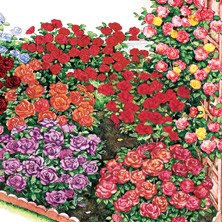 Foundation Planting - You should plant bulbs in groups of 12 or more to add colour in the early spring to a
foundation planting. Evergreen shrubs planted in the foundation planting will provide a nice background for the
bulbs. Pay attention to the foliage colour of
annuals and perennials, as they too will become a backdrop for your
bulbs.
Foundation Planting - You should plant bulbs in groups of 12 or more to add colour in the early spring to a
foundation planting. Evergreen shrubs planted in the foundation planting will provide a nice background for the
bulbs. Pay attention to the foliage colour of
annuals and perennials, as they too will become a backdrop for your
bulbs. Plant early flowering bulbs in your lawn with three easy steps:
1. Use the back of a shovel to dig an 8 cm deep slit into the grass.
2. Lift up the sod and plant 4-5 bulbs.
3. Remove the shovel and tamp down the sod with your foot.

 Deciduous Shrubs and Trees - Spring flowering bulbs
can be planted under deciduous shrubs or small trees in the landscape. However, you should
not plant spring bulbs under evergreen shrubs or they will not have enough light to grow and bloom.
Early blooming bulbs receive plenty of light because they start growing long before deciduous trees and
shrubs start to develop leaves. Some bulbs that perform well under trees and shrubs include: grape hyacinths, crocus, winter aconites,
snowdrops, bluebells and early
maturing daffodils.
Deciduous Shrubs and Trees - Spring flowering bulbs
can be planted under deciduous shrubs or small trees in the landscape. However, you should
not plant spring bulbs under evergreen shrubs or they will not have enough light to grow and bloom.
Early blooming bulbs receive plenty of light because they start growing long before deciduous trees and
shrubs start to develop leaves. Some bulbs that perform well under trees and shrubs include: grape hyacinths, crocus, winter aconites,
snowdrops, bluebells and early
maturing daffodils. By carefully selecting spring bulbs to match blooming dates with the bloom of the shrub, they can provide a beautiful colour contrast with early flowering shrubs such as forsythia or flowering quince. They can also be used in combination with smaller flowering trees like Crabapple, Bradford Pear or Redbud.

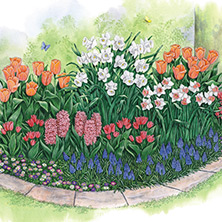 Border Planting - A border of low growing bulbs such as grape hyacinths, hyacinths or small daffodils planted around the edge of a
vegetable garden or flower bed
adds interest to these areas. A border of bulbs planted along the edge of the lawn will add a splash of colour to the lawn
area.
Border Planting - A border of low growing bulbs such as grape hyacinths, hyacinths or small daffodils planted around the edge of a
vegetable garden or flower bed
adds interest to these areas. A border of bulbs planted along the edge of the lawn will add a splash of colour to the lawn
area.

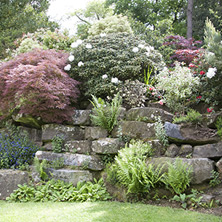 Perennial Beds & Rock Gardens - Spring bulbs can be designed into a perennial bed or border to add areas of
spring colour. The bulbs will bloom during March, April and May before perennials start to flower. Locate the bulbs
in the flower bed so that the dying foliage will be hidden when the perennials start to come in. When planning
borders, it is essential to take into consideration the heights and spacing needed by different plants for a visually
pleasing effect.
Perennial Beds & Rock Gardens - Spring bulbs can be designed into a perennial bed or border to add areas of
spring colour. The bulbs will bloom during March, April and May before perennials start to flower. Locate the bulbs
in the flower bed so that the dying foliage will be hidden when the perennials start to come in. When planning
borders, it is essential to take into consideration the heights and spacing needed by different plants for a visually
pleasing effect.

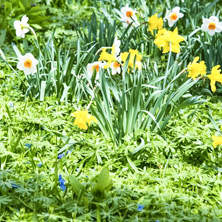 Ground Cover - Some bulbs can be planted with low growing ground covers like ajuga, violets, vinca minor or English
Ivy. Just be sure to keep in mind
the height relationship between the ground cover and bulb flower. As a general rule, the ground cover should be no more
than half the height of the bulb
flower.
Ground Cover - Some bulbs can be planted with low growing ground covers like ajuga, violets, vinca minor or English
Ivy. Just be sure to keep in mind
the height relationship between the ground cover and bulb flower. As a general rule, the ground cover should be no more
than half the height of the bulb
flower.

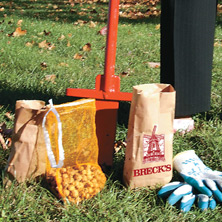 Lawn Area - The corner of the lawn is a great place to develop a new flower bed. These beds are often composed of
small shrubs and perennials. One or two groupings of spring
bulbs of one colour located in the flower bed will provide a point of focus during the spring months. Two great bulbs for
this area are snowdrops and crocus. You can plant these under
trees and shrubs or scatter them
freely over the lawn. These are the first blooms to appear after a long dreary winter.
Lawn Area - The corner of the lawn is a great place to develop a new flower bed. These beds are often composed of
small shrubs and perennials. One or two groupings of spring
bulbs of one colour located in the flower bed will provide a point of focus during the spring months. Two great bulbs for
this area are snowdrops and crocus. You can plant these under
trees and shrubs or scatter them
freely over the lawn. These are the first blooms to appear after a long dreary winter. Plant early flowering bulbs in your lawn with 3 easy steps.
1. Use the back of a shovel to dig a 3" deep slit into the grass
2. Lift up the sod and plant 4-5 bulbs
3. Remove the shovel and tamp down the sod with your foot
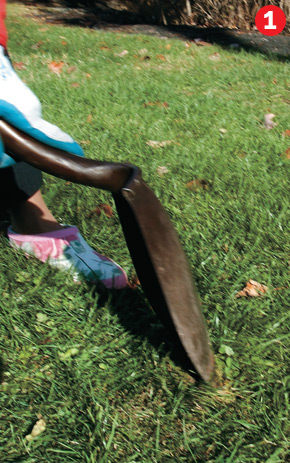
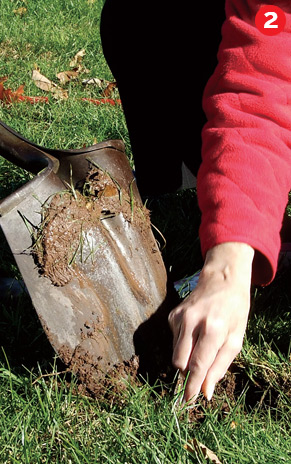
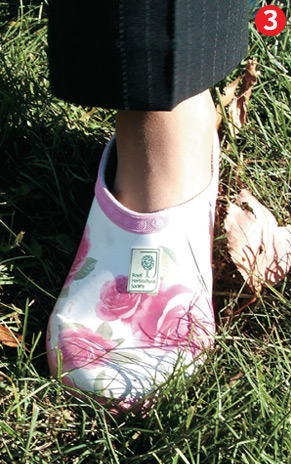

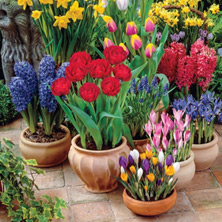 Containers - Both spring and summer
bulbs can be planted in portable
containers. If spring bulbs are planted, the container can be moved to a location out
of sight while the foliage
matures, once the bloom time is past. If summer bulbs are used, they will add colour
all summer long to areas such as a
patio or a deck. Containers are portable and they can be moved around and used in different areas of the landscape. When
relocating a container in the
landscape, pay attention to the light requirements of the bulbs and be sure the container has drainage holes.
Containers - Both spring and summer
bulbs can be planted in portable
containers. If spring bulbs are planted, the container can be moved to a location out
of sight while the foliage
matures, once the bloom time is past. If summer bulbs are used, they will add colour
all summer long to areas such as a
patio or a deck. Containers are portable and they can be moved around and used in different areas of the landscape. When
relocating a container in the
landscape, pay attention to the light requirements of the bulbs and be sure the container has drainage holes.

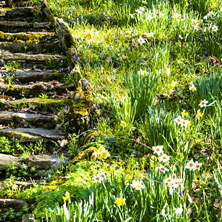 Steep Slopes - Steep slopes in the landscape are difficult to mow and maintain. Many gardeners are now usingdaffodils on these steep slopes to add early spring colour to the landscape. Another
effective option is to use the
perennial, daylily, which has a fiberous root system. The foliage is attractive and the bloom adds colour to the area. By
using daylilies, you eliminate the problem of trying to mow that area of the landscape.
Steep Slopes - Steep slopes in the landscape are difficult to mow and maintain. Many gardeners are now usingdaffodils on these steep slopes to add early spring colour to the landscape. Another
effective option is to use the
perennial, daylily, which has a fiberous root system. The foliage is attractive and the bloom adds colour to the area. By
using daylilies, you eliminate the problem of trying to mow that area of the landscape.
Have another question? Return to the Customer Service Help page or send an e-mail directly to Customer Service.



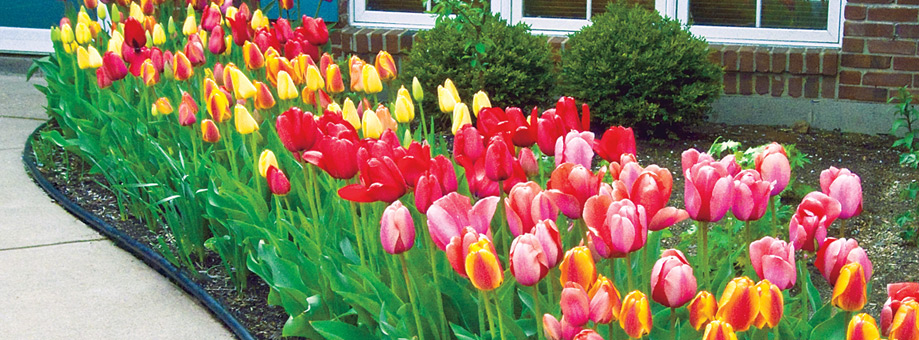
 Landscaping with Bulbs: Size
Landscaping with Bulbs: Size 




